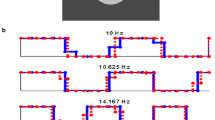Summary
Experiments are described measuring ERG's and occipital EEG's and de Lange curves under identical conditions. There is little correspondence between the responses and the psychophysical results. ERG responses as found by Gouras & Gunkel give second harmonics at about 10 cps. Curves are shown in which the h.f. attenuation is smaller for the ERG and EEG responses than for the de Lange curves. The EEG responses with large field illumination show a linear and highly variable character with different subjects between 9–15 cps. A sharp resonance at 10 cps is reported in one subject. Strong essential second harmonics are found in the EEG below 9 cps and with small fields and high intensities round 27 cps. Opposite phase stimulation cancels fundamental frequency responses and does not influence second harmonics. Also here little relation is found with psychophysical results.
Résumé
On décrit des expériences dans lesquelles l'ERG, l'EEG occipital et les courbes selon De Lange sont déterminées dans des conditions identiques. Il n'y a pas beaucoup de rapport entre les trois. Gouras & Gunkel ont trouvé des distortions doubles harmoniques dans l'ERG à une fréquence d'environ 10 cps. On montre des courbes dans lesquelles l'atténuation h.f. est moins pour l'ERG et l'EEG que pour les courbes subjectives.
Les réponses de l'ERG avec les champs étendus entre 9–15 cps sont linéaires et montrent une variation considérable entre les sujets. Une résonance aiguë est trouvée chez une personne à 10 cps. Des doubles harmoniques essentielles dans l'EEG sont rapportées au-dessous de 9 cps et avec des champs petits et des intensités élevées environ 27 cps. La stimulation avec des phases opposées supprime la fréquence fundamentale, mais laisse les doubles harmoniques intactes. Aussi dans ce cas il n'y a pas beaucoup de rélation avec la perception de flicker.
Zusammenfassung
Es werden Experimente beschrieben, in denen ERG's, occipitale EEG's und de Lange Kurven unter identischen Bedingungen gemessen werden. Man fand nicht viel Übereinstimmung zwischen den elektrischen Reaktionen und den psychophysischen Ergebnissen. Gouras & Gunkel berichten über ERG Antworten um 10 Hz mit hervorragenden zweiten Obertönen. Kurven werden gezeigt, in denen ERG und EEG Reaktionen eine kleinere h.f. Abschwächung angeben als die de Lange Kurven.
Die EEG Antworten mit Grossfeldbelichtung haben einen linearen Charakter zwischen 9 und 15 Hz und sind individuel unterschieden. In einer Person wird über eine scharfe Resonanz berichtet um 10 Hz, grosse zweite Obertöne wurden gefunden unter 9 Hz und mit kleinen und leuchtstarken Feldern um 27 Hz.
Reizung mit Gegenphase für jedes Auge unterdrückt die Grundfrequenz, aber lässt die zweiten Obertöne ungeändert. Auch hier ist wenig Korrespondenz mit psychophysischen Ergebnissen.
Similar content being viewed by others
References
Brazier, M. A. B. (1964) A study of the Variability of Response to Flicker: The Influence of Other Sensory Stimuli. Symposium, Amsterdam 1963. Docum. Ophthal. XVIII: 221–237.
Campbell, F. W. & Robson J. G. (1964) The Attenuation Characteristics of the Visual System Determined by Measurements of Flicker Treshold, Brightness and Pupillo-motor Effect of Modulated Light. Symposium, Amsterdam 1963. Docum. Ophthal. XVIII: 83–84.
Deniervan derGon, J. J., Strackee, Jan & van derTweel, L. H. (1958) A Source for Modulated Light. Physics in Med. and Biol. 3, 2: 164–173.
DeVoe, R. D. (1964) Linear Electrical Fllicker Responses from the Eye of the Wolf Spider. Symposium, Amsterdam 1963. Docum. Ophthal. XVIII: 128–136.
Gouras, P. & Gunkel, R. D. (1962) The Resonant Frequencies of Rod and Cone Electroretinograms. Invest. Ophthal. 1: 122–126.
— &—, (1964) The Frequency Response of Normal, Rod Achromat and Nyctalope ERG's to Sinusoidal Monochromatic Light Stimulation. Symposium, Amsterdam 1963. Docum. Ophthal. XVIII: 137–150.
Kamp, A., Sem-Jacobson, C. W., StormvanLeeuwen, W. & van derTweel, L. H. (1960) Cortical Responses to Modulated Light in the Human Subject. Acta physiol. scand. 48: 1–12.
Kelly, D. H. (1964) Sine Waves and Flicker Fusion. Symposium, Amsterdam 1963. Docum. Ophthal. XVIII: 16–35.
Leutscher-Hazelhoff, J. T. & Kuiper, J. W. (1964) Responses of the Blowfly (Calli- phora erythrocephala) to Licht Flashes and to Sinusoidally Modulated Light. Symposium, Amsterdam 1963. Docum. Ophthal. XVIII: 275–283.
Levinson, J. (1964) Nonlinear and Spatial Effects in the Perception of Flicker. Symposium, Amsterdam 1963. Docum. Ophthal. XVIII: 36–55.
Riggs, L. A., Cavonius, C. E. & Johnson, E. P. (1961) Photographic Cumulation of Recurrent Response Potentials. Nature, Lond. 189: 383–384.
van derTweel, L. H.(1961) Some Problems in Vision Regarded with Respect to Linearity and Frequency Response. Ann. New York Acad. Sci. 89: 829–856.
— Sem-Jacobson, Carl W., Kamp, A., Storm vanLeeuwen, W. & Veringa, F. T. H. (1958) Objective Determination of Responses to Modulated Light. Acta physiol. pharmacol. neerl. 7: 528–529.
— & Visser P. (1960) Electrical Responses of the Retina to Modulated Light. Acta Fac. Med. Univ. Brun. 4: 185–196.
Veringa, F. (1964) Electro-Optical Stimulation of the Human Retina as a Research Technique. Symposium, Amsterdam 1963. Docum. Ophthal. XVIII: 72–82.
Author information
Authors and Affiliations
Additional information
Part of this work was supported by Contract no N. 62558-2701 of the US Navy European Research Contracts Program.
Laboratory of Medical Physics, University of Amsterdam.
Rights and permissions
About this article
Cite this article
van der Tweel, L.H. Relation between psychophysics and electrophysiology of flicker. Doc Ophthalmol 18, 287–304 (1964). https://doi.org/10.1007/BF00160581
Issue Date:
DOI: https://doi.org/10.1007/BF00160581




